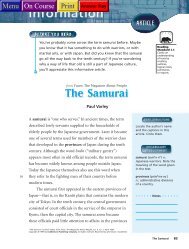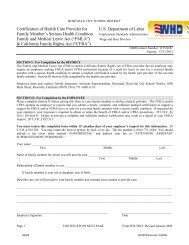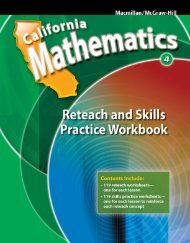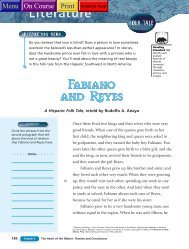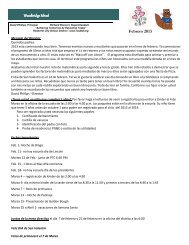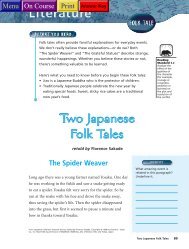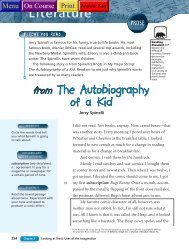Interactive Reading
Interactive Reading
Interactive Reading
You also want an ePaper? Increase the reach of your titles
YUMPU automatically turns print PDFs into web optimized ePapers that Google loves.
Chapter 4Pupil Pages 140–177In the early 1980s, Virginia Hamilton, who had alreadypublished many novels and biographies, decided to tryher hand at writing folk tales. In 1985, she publishedThe People Could Fly, a collection of African Americanfolk tales dating from the time of slavery. Hamilton went on to publishthree more collections of folk tales: In the Beginning: CreationStories from Around the World (1988); Her Stories, African AmericanFolktales, Fairy Tales, and True Tales (1995); and When Birds CouldTalk & Bats Could Sing (1996).Speaking of her four volumes of folk tales, Hamilton notes: “Noneof these stories was ever written for children. They were just told;so I redid them, brought them out of the musty old manuscriptswhere nobody ever saw them.” She often finds the stories in oldmanuscripts or out-of-print materials in libraries.Here’s what you might like to know before you begin these twoversions of “Little Red Riding-Hood”:• Like many folk tales, the story of Little Red Riding-Hood is foundin different cultures around the world. Each culture puts its ownunique spin on the story.• Virginia Hamilton uses dialect in her version of the folk taleto describe her characters and setting. Dialect is the way peoplein a certain region, or even in a certain age group, speak.When dialect appears in print, the words are often spelled andpronounced differently from the way they are in standard English.156 Chapter 4 Forms and Patterns: Stories and Explanations<strong>Reading</strong>Standard 3.1Identify theforms of fiction,and describethe majorcharacteristicsof each form.1020An African American folk tale retold by Virginia HamiltonOne day Little Daughter was pickin some flowers. Therewas a fence around the house she lived in with her papa.Papa didn’t want Little Daughter to run in the forest, wherethere were wolves. He told Little Daughter never to go outthe gate alone.“Oh, I won’t, Papa,” said Little Daughter.One mornin her papa had to go away for somethin.And Little Daughter thought she’d go huntin for flowers.She just thought it wouldn’t harm anythin to peep throughthe gate. And that’s what she did. She saw a wild yellowflower so near to the gate that she stepped outside andpicked it.Little Daughter was outside the fence now. She sawanother pretty flower. She skipped over and got it, held itin her hand. It smelled sweet. She saw another and she gotit, too. Put it with the others. She was makin a pretty bunchto put in her vase for the table. And so Little Daughter gotfarther and farther away from the cabin. She picked theflowers, and the whole time she sang a sweet song.All at once Little Daughter heard a noise. She lookedup and saw a great big wolf. The wolf said to her, in a low,gruff voice, said, “Sing that sweetest, goodest song again.”So the little child sang it, sang:“Tray-bla, tray-bla, cum qua, kimo.”And, pit-a-pat, pit-a-pat, pit-a-pat, pit-a-pat, LittleDaughter tiptoed toward the gate. She’s goin back home.But she hears big and heavy, PIT-A-PAT, PIT-A-PAT, cominUnderline the words in thefirst paragraph that help youpredict that this is a RedRiding-Hood story.“A Wolf and LittleDaughter” is written toimitate a storyteller’s voice.Read the boxed passagealoud. Remember that thewords are spelled the waythey are pronounced.Sometimes the typeface willtell how to read the text—for example, pit-a-pat andPIT-A-PAT. How do you thinkthese words shouldbe read?Pit-a-pat is the soundof Little Daughtertiptoeing away; PIT-A-PAT is the sound of thewolf coming closer,and should be readwith increased volume.“A Wolf and Little Daughter” from The People Could Fly: American Black Folktales by Virginia Hamilton.Copyright © 1985 by Virginia Hamilton. Reprinted by permission of Alfred A. Knopf Children’s Books,a division of Random House, Inc.Virginia Hamilton 157198 <strong>Interactive</strong> <strong>Reading</strong>: Teacher’s Edition




